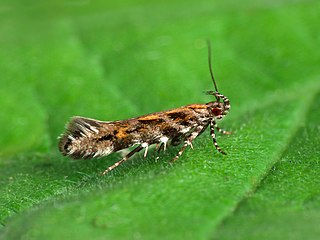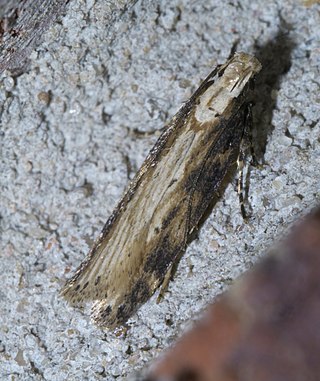
Cosmopterix chisosensis is a moth of the family Cosmopterigidae. It is known from Argentina and the United States.

Cosmopterix thelxinoe is a moth of the family Cosmopterigidae. It is known from Brazil and the United States.

Aristotelia ericinella is a moth of the family Gelechiidae. It is found in most of Europe, except most of the Balkan Peninsula.
Dichomeris cyanoneura is a moth in the family Gelechiidae. It was described by Edward Meyrick in 1922. It is found in Guyana and Pará, Brazil.

Chionodes hibiscella is a moth in the family Gelechiidae. It is found in North America, where it has been recorded from Connecticut and Illinois to South Carolina, Louisiana, Mississippi and Texas.
Prolita barnesiella is a moth of the family Gelechiidae. It was described by August Busck in 1903. It is found in North America, where it has been recorded from California, Colorado, Arizona, New Mexico, Texas, Wyoming and Utah.
Aristotelia paphia is a moth of the family Gelechiidae. It was described by Edward Meyrick in 1917. It is found in Peru.
Aristotelia chlorographa is a moth of the family Gelechiidae. It was described by Edward Meyrick in 1914. It is found in Mozambique and South Africa, where it has been recorded from Gauteng.
Aristotelia resinosa is a moth of the family Gelechiidae. It was described by Edward Meyrick in 1918. It is found in Assam, India.
Aristotelia ptilastis is a moth of the family Gelechiidae. It was described by Edward Meyrick in 1909. It is found in South Africa, where it has been recorded from the Western Cape.
Aristotelia argentifera is a moth of the family Gelechiidae. It was described by August Busck in 1903. It is found in North America, where it has been recorded from California and western Nevada.

Aristotelia elegantella is a moth of the family Gelechiidae. It was described by Vactor Tousey Chambers in 1874. It is found in North America, where it has been recorded from Arizona, California, Colorado, Illinois, Indiana, Iowa, Kansas, Kentucky, Louisiana, Mississippi, New Mexico, Ohio, Oklahoma, Ontario, Texas and Utah.
Aristotelia lindanella is a moth of the family Gelechiidae. It was described by William Barnes and August Busck in 1920. It is found in North America, where it has been recorded from California.
Aristotelia pyrodercia is a moth of the family Gelechiidae. It was described by Walsingham in 1910. It is found in Mexico (Guerrero).
Aristotelia sarcodes is a moth of the family Gelechiidae. It was described by Walsingham in 1910. It is found in Panama and on the Galapagos Islands.
Monochroa angustipennella is a moth of the family Gelechiidae. It was described by James Brackenridge Clemens in 1863. It is found in North America, where it has been recorded from California, Illinois, Maine, New Jersey, New York, Ohio, Oklahoma and Pennsylvania.
Hastamea argentidorsella is a moth in the family Depressariidae, and the only species in the genus Hastamea. It was described by August Busck in 1911 and is found in Brazil (Paraná).
Coptotelia bipunctalis is a moth in the family Depressariidae. It was described by Warren in 1889. It is found in Brazil.
Coptotelia nigriplaga is a moth in the family Depressariidae. It was described by Paul Dognin in 1904. It is found in Colombia and Ecuador.
Cerconota carbonifer is a moth in the family Depressariidae. It was described by August Busck in 1914. It is found in Panama, Costa Rica and French Guiana.


